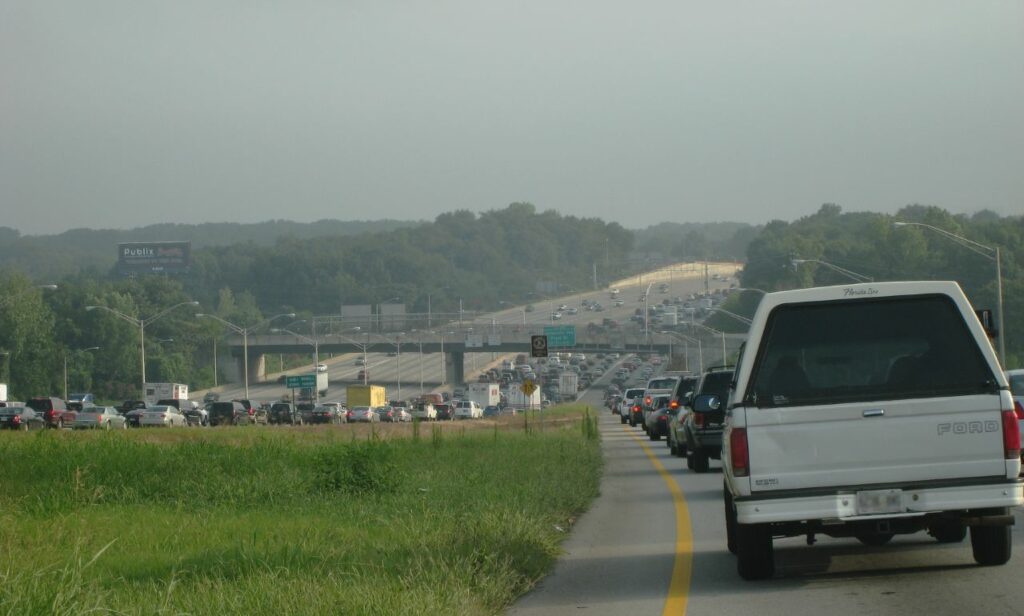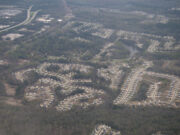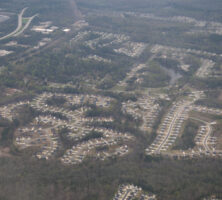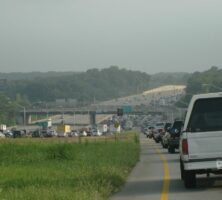The environmental impacts of urban sprawl in Georgia are among the most significant and widespread in the nation. According to the U.S. census, between 2000 and 2010 Georgia’s population increased 18.3 percent, nearly twice the national average of 9.7 percent. In that decade, Georgia’s population increased by 1.5 million, the fourth highest numeric increase in the country (behind Texas, California, and Florida).
The Atlanta region, home to about 5.2 million, is the ninth most populous metropolitan statistical area in the country, and its population increased by 24 percent between 2000 and 2010. The three largest growing counties in the state are all either in the Atlanta metro region or immediately adjacent: Henry, Forsyth, and Paulding counties had population increases of 78 percent, 74 percent, and 71 percent respectively between 2000 and 2010. While growth and development have both diversified and strengthened Georgia’s economy, rapid and seemingly unchecked growth is responsible for major environmental impacts that must be addressed in order to preserve the quality of life for Georgia citizens.
Sprawl in Georgia
Atlanta is the largest metropolitan area in the Southeast. The Atlanta Regional Commission defines the metro Atlanta area as the following ten counties: Cherokee, Clayton, Cobb, DeKalb, Douglas, Fayette, Fulton, Gwinnett, Henry, and Rockdale. There are no large bodies of water, mountains, or major federal land holdings to limit the city’s outward growth. Home to 5.2 million people (up from 1.8 million in 1970), Atlanta continues to have the fastest growth rate of any southeastern city with a population of more than a million people. Atlanta’s urban land area expanded nearly 35 percent between 2000 and 2010, following a 47 percent expansion between 1990 and 1996 and a 25 percent expansion between 1980 and 1990. These trends are likely to continue. Some experts believe that the region’s population could double by 2050.
Although growth tends to be associated with the metropolitan Atlanta area, other regions in Georgia are also experiencing population increases. Coastal Georgia expects to reach a population of more than 840,000 by 2030, a 51 percent increase from its 2000 population, and Georgia’s mountainous regions are expected to increase in population by around 2 percent each year through 2030.
Air Quality
The metropolitan Atlanta region has more than 16,000 miles of roads, the second-highest number of miles per capita of any metropolitan area in the nation. Despite this abundance of asphalt, Atlanta has the fifteenth-worst traffic congestion in the country. Consequently, the air quality of metro Atlanta is a significant concern; the impacts of poor air quality on human health are substantial. In 2014 the American Lung Association ranked Atlanta the eighteenth most polluted city in terms of year-round particle pollution. According to the Georgia chapter of the American Lung Association, excessive particle pollution makes thousands of Atlanta-area emphysema, bronchitis, and asthma cases substantially worse each year. A 1994 study by the Centers for Disease Control and Prevention found that after ozone alerts, emergency rooms in Atlanta regional hospitals reported a 37 percent increase in admissions for respiratory ailments, and the number of asthmatic children who visit metropolitan emergency rooms increased by one-third. Other cities in the state, including Columbus, Macon, and Augusta, are faced with worsening air quality as well. In 2014 the American Lung Association ranked Macon the fifteenth worst city in the nation for year-round particle pollution.

Photograph by Doug Waldron
Water Quality
The rapid rate of growth in Georgia, coupled with limited water resources, results in concerns about water quality and quantity. Statewide, thirty-two of Georgia’s fifty-three monitored watersheds have documented water quality problems. These waters are threatened primarily by pollution associated with poor development practices and urban storm-water runoff. Half of all Georgians drink water drawn from the Chattahoochee River. The water quality of the Chattahoochee is threatened by rampant suburban growth and inadequate or aging water and sewer systems (in some areas); runoff from paved surfaces, agriculture lands, and lawns; erosion from construction sites; and seepage from septic tanks. One million metro Atlantans still use septic tanks—more than in any other major metropolitan area. At the same time Atlanta has faced serious problems in the maintenance of its wastewater infrastructure. The Environmental Protection Agency has imposed significant fines on the city of Atlanta for spills and leaks from its overloaded sewer system.

Photograph by Maik
The pressure created by population growth and development has an impact on water quality in other areas of the state as well. Increasing withdrawals of water for public supply, industrial uses, power production, and irrigation are placing stress on Georgia’s rivers and making it more difficult to meet in-stream flow needs for such uses as water-quality protection, recreation, and fish and wildlife habitat. Groundwater levels are also threatened by overuse. Heavy groundwater withdrawals in the Savannah area are contributing to saltwater intrusion in the Upper Floridan aquifer, and in Brunswick saltwater has moved up from a deeper zone into the previously freshwater zone, contaminating wells.
Loss of Greenspace
Metropolitan Atlanta is the least densely populated metropolitan area in the United States, with only 1,370 persons per square mile, compared with 5,400 persons per square mile in Los Angeles. Between 1982 and 1992 the amount of greenspace lost to development in the Atlanta metropolitan area increased by 38 percent. In 2005 Atlanta lost 500 acres of open space each week to development. In 2014 the nonprofit ParkScore organization ranked Atlanta forty-second out of sixty U.S. cities in terms of park effectiveness.
Much of this loss is a direct result of encroachment by low-density sprawl development into forested and agricultural areas. The deforestation and loss of vegetation, coupled with increased pavement and rooftops, creates a “heat island” effect (temperatures can be up to twelve degrees higher in heavily paved areas of Atlanta) and contributes to the region’s air pollution problems as well. Loss of greenspace is not confined to the Atlanta area; it is a statewide problem. Georgia ranks third, after Florida and Texas, in the nation in the amount of farmland and woodland being converted to subdivisions, malls, and other development. Between 1982 and 2007, nearly 648,000 acres of the state’s farmlands and forests were developed.
Solutions
Steps are being taken in response to the environmental problems created by rapid growth in the state. For example, the Georgia General Assembly established the Georgia Regional Transportation Authority in 1999 to oversee transportation and land use in the metropolitan Atlanta region. The Georgia Community Greenspace Program, active from 2000 to 2004, was designed to set aside 20 percent of rapidly developing counties as greenspace.
Atlanta also began in the early twenty-first century to promote “smart growth” or “mixed development” projects in which homes and businesses would be within walking distance of one another. Atlantic Station, just south of Buckhead, opened in October 2003 on a reclaimed brownfield, the 138-acre site of the vacant Atlantic Steel Company. By 2015 it was home to more than 3,000 residents and included more than 6 million square feet of office space. The Atlanta Beltline, an ambitious transit corridor scheduled to circle the city by 2030, increases transportation options for Atlantans by linking intown neighborhoods with pedestrian and bicycle paths and creates development opportunities along the path’s projected twenty-two-mile perimeter. The first section of the path, built on old railroad tracks in the city’s West End neighborhood, opened in 2008.
Finally, residents are starting to move back inside the city limits. The 2010 U.S. census shows that population densities are rising. Atlanta’s population increased by more than 1 million residents between 2000 and 2010, and it increased by 22,000 during the 1990s, reversing a long population decline that began in the 1970s. Effective remedies against the environmental problems created by sprawl will require growth management strategies that protect the quality of Georgia’s water and air and the high quality of life enjoyed by its citizens.








